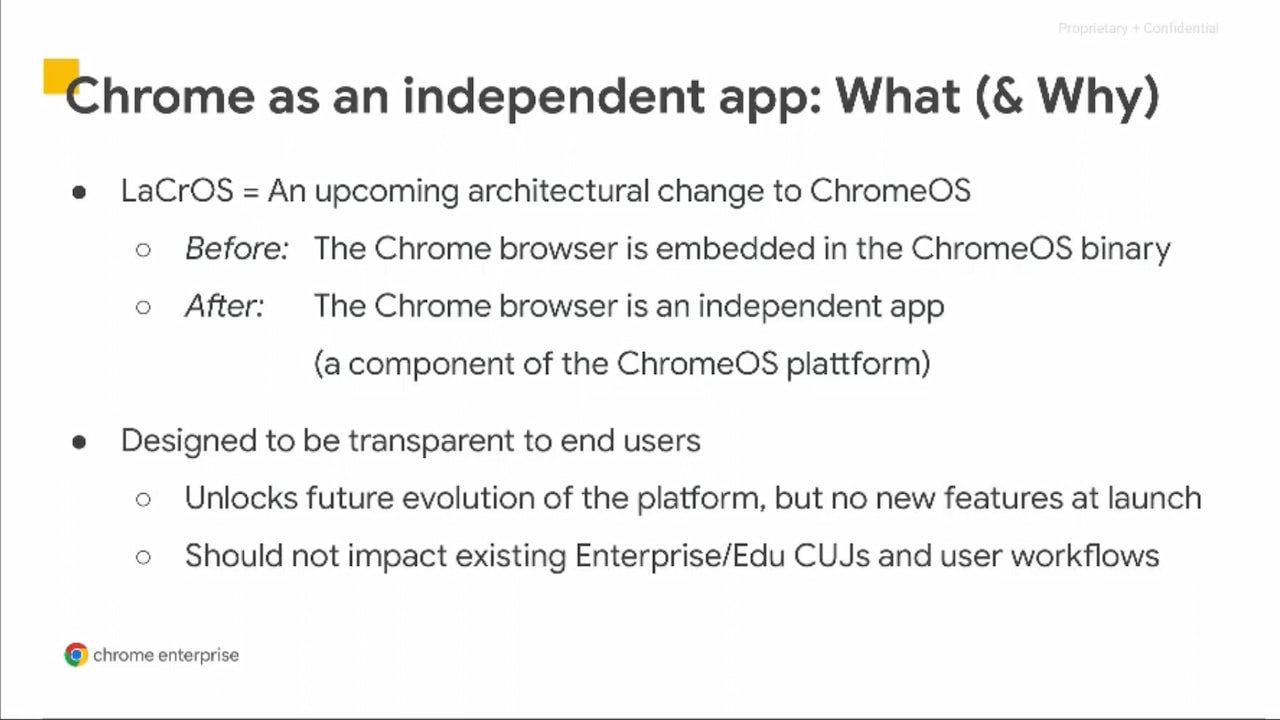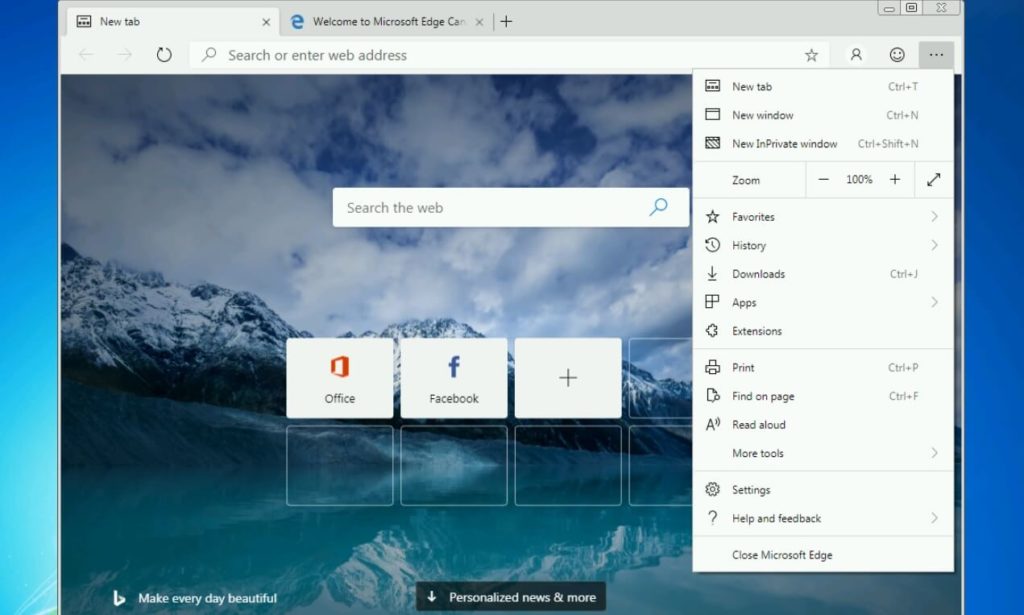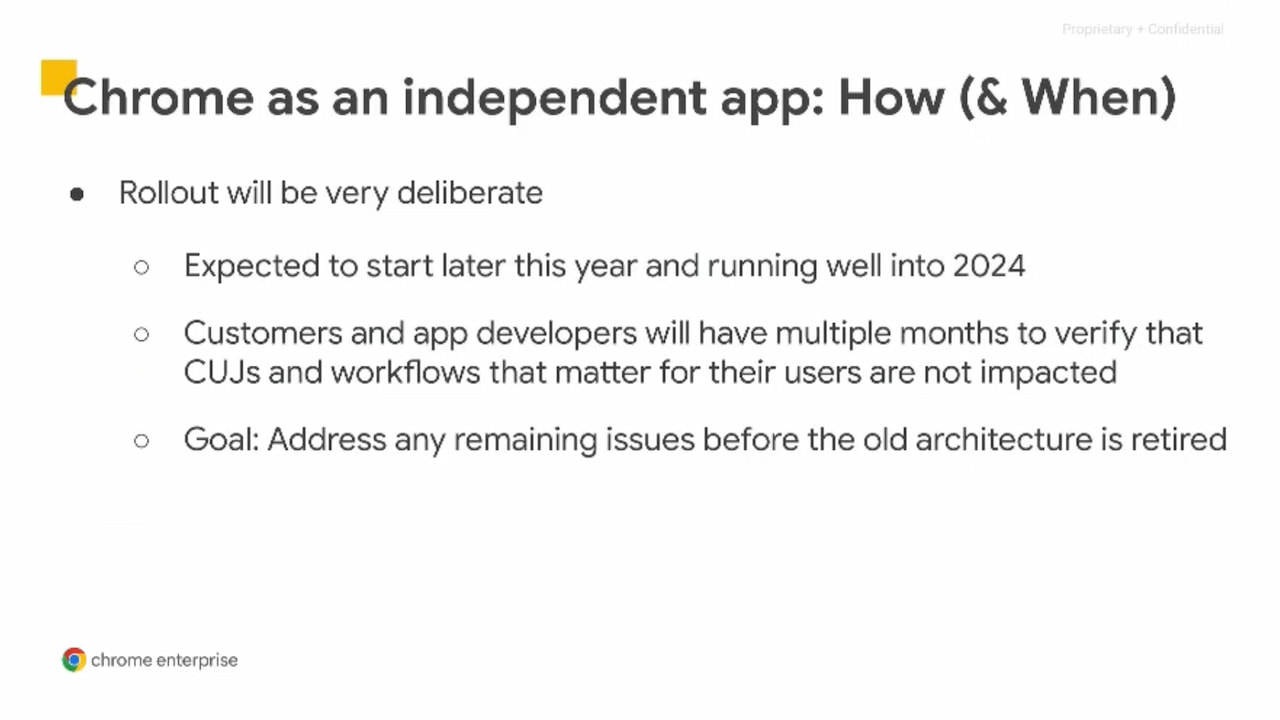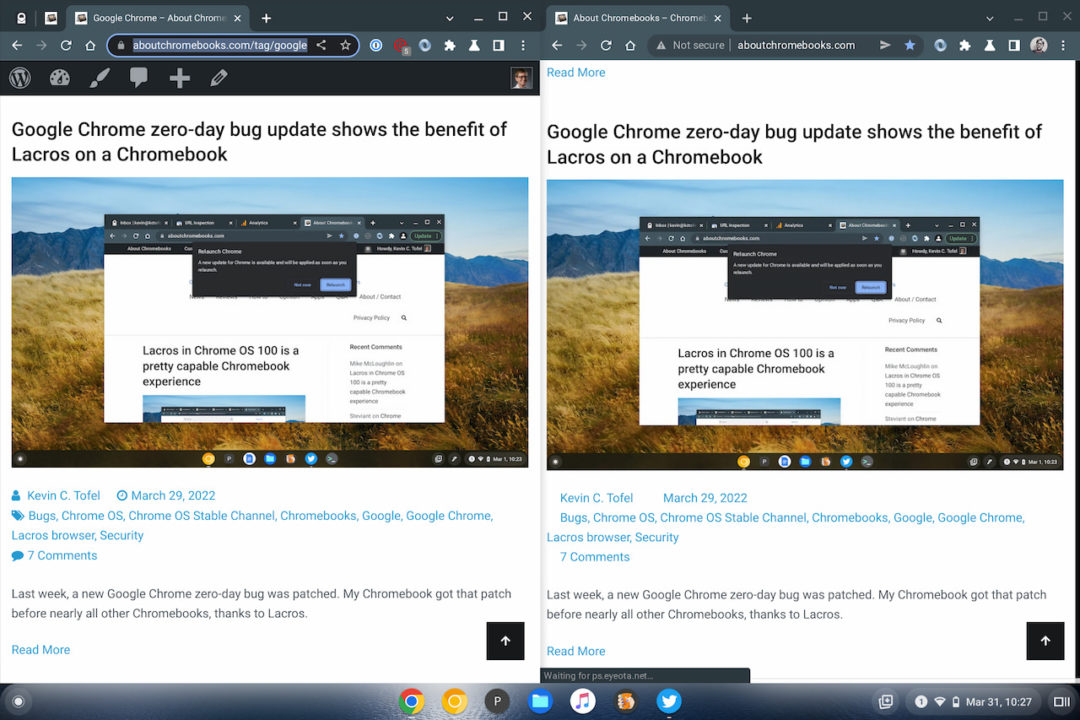Last week I noted that ChromeOS 116 is the likely beginning for Google to decouple the Chrome browser from ChromeOS. This effort has taken nearly three years so far and there’s no near-term end in sight. Based on details shared by Google, the Lacros on Chromebooks transition plan won’t be quick. Expect it to last for a year.
Lacros on Chromebooks detailed for developers
Google recently shared the below video webinar outlining the Lacros on Chromebooks transition plan, which is how I found out about the details. The video is targeted at Chrome developers and, to a lesser degree, those who manage Google Chrome in an enterprise location.
Right off the bat, Google says it has opened up the usage of Lacros on Chromebooks to trusted testers. So yes, we’re in the homestretch of this transition to turn the Chrome browser into a separate application on Chromebooks.
A recap of what Lacros on Chromebooks is
For those who haven’t been following this, Lacros is basically the Chrome browser for Linux, but with integrations needed for ChromeOS.
I covered why Google is doing this and Google recaps it in the video, but here’s the high-level reason. In the current situation, whenever the Chrome browser needs an update, say for a security patch, Google has to push that to Chromebooks in a ChromeOS update. That takes more time and effort than it does for the Chrome browser on Linux, macOS, and Windows.

By making Chrome an independent application on Chromebooks, Google can push browser updates quicker. And it doesn’t have to maintain a separate browser codebase for Chromebooks. Although those are big benefits alone, there might be another one. It’s possible that once the automatic software update expiration date passes on a Chromebook, the browser itself could get updates. That means it could continue to gain security patches and other features.
Keep in mind that this scenario isn’t the officially stated reason Google has created Lacros. This is simply a possibility worth mentioning.
Current Chrome and ChromeOS architecture changes
When you get an idea of how the current Chrome browser works within ChromeOS, you can see why Lacros on Chromebooks has taken so long. The current Chrome browser is heavily integrated within ChromeOS, as shown below. The “Browser” section on the right side of the diagram is the current state.

Lacros on Chromebooks moves the Chrome browser outside (to the left) of ChromeOS. And it’s not as simple as simply installing Chrome. That’s because the operating system has many integration points with the browser. Every arrow on the above diagram is either one of the integration points or some messaging between the browser and ChromeOS.
Think of it this way with the simple example of downloading a file from the Chrome browser. (Yes, I know that third-party browsers on Chromebooks can download and save files from the internet. I’m using this as an example of all browser functionality that interacts with an operating system using a simple scenario. Such third-party browsers also use the APIs and services from the platforms they run on, i.e. Android and Linux, which is why they work today for this use case.)

On a Windows device, the Chrome browser uses already established Windows APIs and services so the device can access the file system and save that file. ChromeOS by comparison also has these integration points. But today, the Chrome browser is part of ChromeOS and the tools needed to access the file system to save the download are within ChromeOS.
So how does a browser that should provide a fully integrated experience on a Chromebook do the same? That browser has to communicate with the operating system which provides some of that functionality. Google has had to create much of that functionality for an external, or non-integrated browser over the past three years.
Lacros and the native Chrome browser will be on Chromebooks during transition
In a bit of good news, you’ll see in the above image that both the current, native Chrome browser and Lacros will be on Chromebooks during the transition period. I was concerned that this might not be the case based on experimental flags I found last week. However, Google is smartly keeping both browser versions on Chromebooks.
This allows a smoother transition in the case of Lacros bugs. If something doesn’t work in that browser, users can fall back to the current Chrome browser and keep on working. It may even be a seamless fallback although I won’t know until I can test further.
Google wants to ensure that ChromeOS users, particularly businesses using Chrome Enterprise, aren’t negatively impacted by their current workflows. Obviously, it’s important for consumer Chromebook users too but the current focus is to have business users and developers iron out the bugs from Lacros.
Lacros on Chromebooks transition plan is about a year
With the trusted tester program for Lacros on Chromebooks already underway, the transition plan has effectively started. In the video webinar, Google said it plans to begin the Lacros rollout within the next few months. Again, ChromeOS 116 shows the first signs of that although Google hasn’t officially mentioned Lacros as part of that version.

For around six months, Lacros will be in a rollout mode, likely with a small but growing number of users over time. Once Lacros on Chromebooks is generally available, Google will spend another several months ironing out any remaining bugs or issues. I would anticipate those to be few because most of the issues should be uncovered during the first half of the transition.
I also expect most traditional Chromebook users to hear about Lacros over the next few months but not actually use it. The independent browser will likely be considered an experimental, feature during the first half of the transition.
The end result for Lacros on Chromebooks

Obviously, I don’t fall into the “most traditional Chromebook users” category. I’ve been using Lacros as a primary browser on my Chromebook since ChromeOS 100. Yes, there are still bugs and issues. I simply deal with them or jump into the excellent Sidekick browser to get around them.
Ideally, as the Lacros on Chromebook transition continues, however, most users should not see any difference with their browser. Well, maybe a few functionality differences since Lacros has far better support for Google account profile switching. Outside of that and a few other features though, everything should look and work the same on your Chromebook.
I’m sure there are questions about this, so chime in with yours below. And of course, I’ll continue to monitor the progress of Lacros, reporting on what I find along the way.


12 Comments
Nice to see the grown ups at Google have taken charge of this.
To think some people thought this would happen about a year or more ago, shows how most are clueless on how anything important is implemented and tested so it works well when released. Glad those people don’t work in medicine etc, am sure Microsoft might hire them though….
Sure loads people will write but my Chromebook just expired and moan about not getting this. Tough decisions need to be made for the greater good.
Hopefully in the long run this does lead to the additional benefit of longer support. Firefox ESR version is supporting Win 7 until Sep 2024 with security updates ( functionality updates just ended July 2023.)
Win 7 released 2009, Firefox support ends Sep 2024, 15 years of Support, well done Firefox 🙂
I have been using Lacros since you wrote about it a week ago, two? In that time I have experienced no problems.
I’m On Chrome OS 116 beta. Can I still enable Lacros? I’m confused as to which flags are relevant right now.
I enabled #lacros-only and now I’m only using Lacros.
Lacros seems to be broken in Chrome OS 118 Beta:
https://bugs.chromium.org/p/chromium/issues/detail?id=1485699&q=OS%3D%22Lacros%22
I’ve reverted the “lacros-only” flag to “Default” so I can let Google sort their mess out and manage my transition for me. I don’t really need the profile switching since YouTube lets me switch accounts on Ash-Chrome now. (this was a problem for me before, so I’m not sure when they fixed it)
Never mind. This doesn’t seem to be an issue for me after all, so I’m back on Lacros.
Why do I have to click to expand the full article, after I already clicked on the article link once on the main page? Seem to me my initial click should be enough to demonstrate I wish to read the article, why do you need to block half of it off after I’ve clicked it, to ask me if I’m sure I want to read it? If I didn’t want to read the article, I wouldn’t have clicked it. You don’t need to ask me twice.
Yeah that is annoying. Seems loads web pages have weird things like this these days, web standards needs tightening or we’ll be back to pop up hell again.
Thanks for your comment. Otherwise, this site is excellent, but this is perhaps the only blemish on its beauty. Moreover, this is a new behaviour that was not here a few weeks or months ago, so something must have changed.
It could just be “feature” of the WordPress theme that this site uses. But it definitely is annoying.
About a year ago I enabled the necessary flags and got Lacros running on a couple of Chromebooks that had gone past their AUE date. The browser runs fine. There is always a button at the top right that says “Update”.
When you click on that button you get a dropdown that says “Chrome is out of date”. When you click on that, you get a message that says Chrome couldn’t update to the latest version, and there’s a button to reinstall Chrome. Clicking on that brings me to the settings page, and that’s it.
I’ve tried manually updating, but there’s no direct way I can see to do that. I’ve been stuck on version 105.0.5195.75 for the duration. I don’t really feel safe using it for anything but simply browsing unless it’s updated.
I see a lot of post around basically saying the same thing. Any suggestions?
I believe there are currently 3 different versions of Chrome for linux (Debian, RedHat, and Arch). Since ChromeOS is built on top of Gentoo, does this mean that LaCros is a 4th variant, or because Gentoo was branched out of git that it’s (maybe) the same as Arch linux?